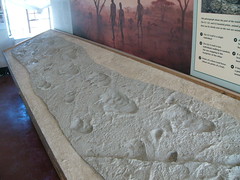 There is a set of footprints in Tanzania, a few dozen metres long, preserved in stone that hardened from fresh volcanic ash, which had been rained upon. Those walking on that ash were side by side, close enough to touch one another. The prints are 3.6 million years old, and they were left by two (or perhaps three) sets of feet—human feet.
There is a set of footprints in Tanzania, a few dozen metres long, preserved in stone that hardened from fresh volcanic ash, which had been rained upon. Those walking on that ash were side by side, close enough to touch one another. The prints are 3.6 million years old, and they were left by two (or perhaps three) sets of feet—human feet.
But the walkers had much smaller brains back then, so some might call them humanoid rather than human. Whatever you call them, they were our relatives (though not actually our direct ancestors). Their footprints include nothing fossilized from their bodies, not one bone. Yet the prints tell us remarkable things: that the apes that left them were human, in that they walked like us, upright on two legs evolved to walk that way, with feet that look like ours.
If you didn't know the prints were millions of years old, you could easily mistake them for a recent set, left by people walking barefoot on the beach. I think that, from the perspective of modern humans, they're one of the most remarkable fossil finds ever. Look at them, and you can easily imagine a group of australopithecines, maybe a family, walking across the plain. Some researchers say the gait of one of the walkers implies it was carrying something, perhaps even a young child, on its hip.
As far as I know, we don't have access to the footprints of Plato or Aristotle, Caesar or Cleopatra, Buddha or Jesus or Muhammad, Shakespeare or Moliere or Confucius, or even of my own grandparents. But we have these ones, eons older. We don't know what happened to those ape-humans of Laetoli after they passed over the ash, but they were walking into their future. And here we are.

I think those people you mentioned left much more than just footprints. :)
Test comment. Please ignore or delete.